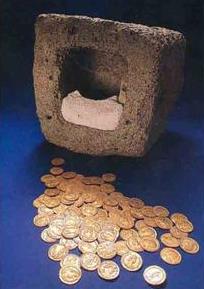Gold Hoard from Caesarea, 344-395 CE
Gold Hoard from Caesarea
One of Israel’s richest archaeological sites—abounding with sculpture, mosaics, pottery, glassware, coins and more—Caesarea Maritima still holds surprises after 21 years of excavation, as two discoveries last season show. In a curious reprise of the recent silver-cache finds at Tel Miqne-Ekron,a volunteers from Concordia College (Moorhead, Minnesota), working at Caesarea under Dr. Olin Storvick, uncovered a hoard of 99 solidi (above), gold coins of the later Roman empire. Found beneath a fragmented mosaic pavement in a room that was probably part of a private dwelling, the coins date to between 344 and 395 A.D. The coins’ owner had secreted them inside a makeshift “safe,” part of a basalt mill stone (shown in photo) that already lay beneath the floor level. A wooden beam by which a donkey turned the mill originally fit into the square opening in the mill stone. The owner had stacked the coins neatly inside this opening and had sealed the opening with white plaster, no doubt never imagining that the coins would remain safe for 1,600 years.
“Caesarea Maritima Yields More Treasures,” BAR Jan-Feb 1994.




